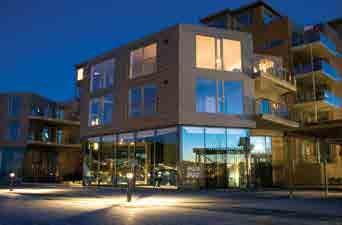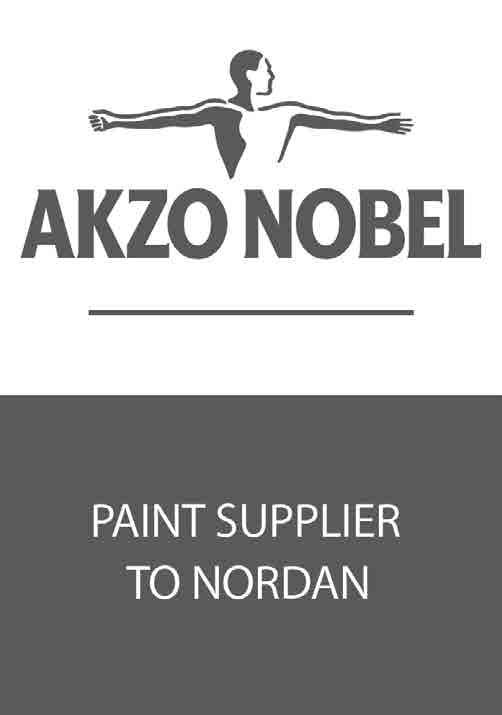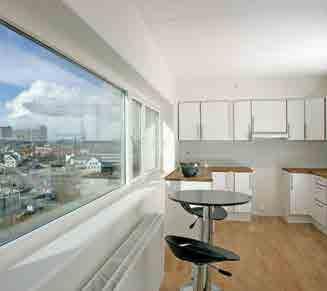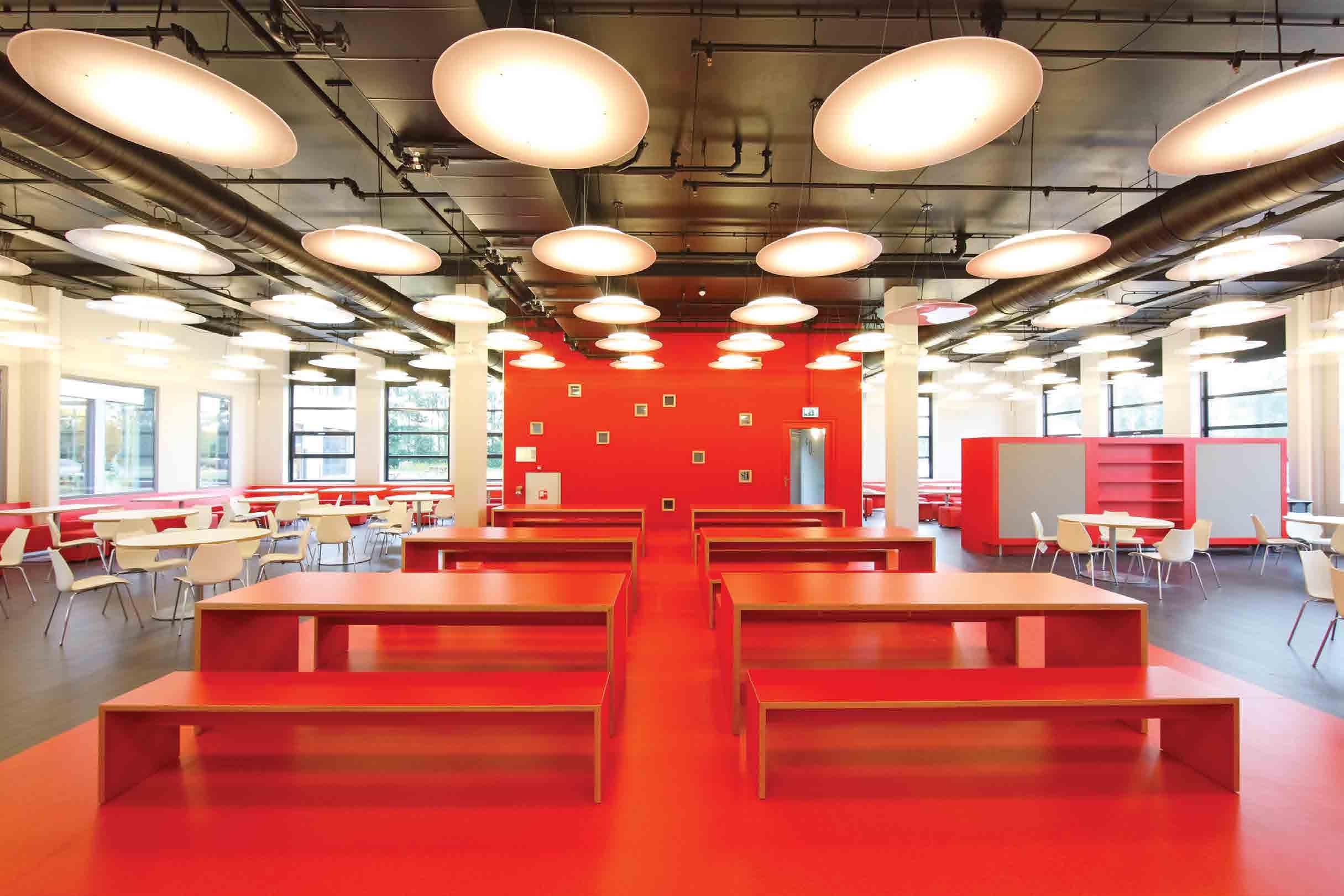
14 minute read
Tarkett Changing floors
Window and insulated sash and frame. These advanced window systems both offer big energy savings, as well as providing unparalleled environmentally friendly and other user benefits and features.
NorDan’s unique ‘N-Tech’ range provides up to 50 per cent reduction in heat loss from buildings. A traditional, single glazed window has a typical ‘K’ value of around 5.0 W/m2K, whereas NorDan’s N-Tech windows have a ‘K’ value of just 0.7 W/m2K, making them the most efficient, insulated windows in the world.
In order to achieve this remarkably low value, NorDan’s in-house R&D department redesigned the thermal surround of the window sash and substituted it with special aluminium spacers and with super-spacers made of silicone. Unlike typical aluminium spacers, which permit heat transfer through the perimeter of glazed units, this super-spacer provides an extremely effective barrier against heat transfer. The result is that the temperatures at the edges of the glass remain several degrees warmer and in turn greatly reduces the risk of condensation and the subsequent heat loss. Furthermore, to enhance the quality still further NorDan also uses the highest performing coated glass and fills the void in its glazed units with Argon gas in order to ensure minimal heat loss outage.


Supporting the Commonwealth Games
The continued demand for NorDan’s products is evidenced in the number of contracts it continues to win. For example, the year (2014) it supplied the timber windows and doors for the Glasgow 2014 Commonwealth Games’ Athletes Village.
The homes in the village were designed to the stricter U-values and air tightness demanded by the 2013 Building Regulations for which NorDan’s timber windows and composite door products were ideal. NorDan supplied high quality high performance tilt and turn timber windows and fully reversible windows from its NTech 1.2 range. External doors were from the NorDan factory at Bor in Sweden, with glazed doors for the ground floors and balconies manufactured at Egersund Norway.
Increasing demand for ‘Passive Window’ insulation
When NorDan launched its low-energy windows with Passive Window insulated sash and frames, building companies and architects alike applauded its many attributes.





The remarkable success of this NorDan patented product has led to increasing demand and the company’s further investment in production capacity.
A company spokesperson said, “We realised that our latest ‘Passive Windows’ would be well received as they tick all the boxes concerning existing and forthcoming EU legislation. However, we were surprised at just how popular these products have become. We are different in many ways from our competitors and we offer a wider range of products that combine innovation with the highest possible quality. Passive Windows offer low, low U values and excellent quality sound insulation, ideal for use in noisy city environments. They also offer significantly reduced UV exposure. Furthermore, we are involved in every step of the value chain from pest-controlled forestry and the design and manufacturing of all components ourselves, even the special glass.
“We are also strategically located in 22 different places which means that we are close to our key markets. We also place a high priority on our key accounts and we do that by offering a truly dedicated and professional service. We are the clear market leaders in Norway and Sweden and deliver our products to private home builders and end users. What we like to say is that “We are large enough to lead and small enough to care”. All our products are tailor-made to suit the specific needs of our customers and they can rely on our ability to deliver the highest quality products – and on time. We have over 3,000 types of products and series customisation means that there are no limits as to what we can produce.” n



CHANGING FLOORS
Tarkett is one of the world’s largest producers of flooring products but its aim today is also to become the leading agent of change in the global flooring industry, creating sustainable and inspiring flooring solutions that will enhance its customers’ quality of life. Peter Mercer meets Tarkett EMEA president, Remco Teulings’ at the company’s Nanterre headquarters.


Tarkett is a global leader in innovative and sustainable solutions for flooring and sports surfaces. The France headquartered company, which posted record net sales of €2.5bn in 2013, serves customers in more than 100 countries across the world. With some 11,000 employees and 30 production sites in four continents, it sells 1.3 million m2 of flooring every single day for housing, hospitals, schools, hotels, offices, retail stores and sports fields. Its products include flooring in vinyl, wood and laminate, linoleum, carpet and rubber as well as synthetic turf and athletics running tracks.
Despite the size of the company today, Tarkett claims that it is still driven by the same deeply rooted entrepreneurial spirit that inspired its founders and it is indeed still in the majority ownership of the Deconinck family, whose involvement goes back to1942, when Bernard Deconinck took over the management of Allibert, the French company that was to merge 30 years later with Sommer, a major French producer of modern floor coverings.
The flooring division of Sommer Allibert then merged in 1997 with Tarkett AB, the Swedish company that had been producing high-quality wooden flooring since the 1880s. After ten years as a public company, Tarkett, as it was then called, delisted, and in 2007 the US venture capital company Kravis Kohlberg Roberts (KKR) acquired 50 per cent of the shares with the Deconinck family holding the other 50 per cent.
Under the new ownership structure, there were significant changes in the senior management, and experts were brought in to accelerate the development and further rationallise the organisation. Then, in November 2013, the company was listed on the Euronext Paris stock exchange, with the Deconinck family now holding a controlling share of 50.1 per cent and KKR reducing its holding to 21.5 per cent.
Commenting on the Group’s record results in 2013, Tarkett CEO Michel Giannuzzi said, “Thanks to its balanced worldwide presence, diversified flooring products portfolio and efficient industrial base, Tarkett has been able to capture growth in the most dynamic regions of the world. 2013 was also a historic year for Tarkett with its listing on Euronext Paris. We remain confident that the Group can pursue its dynamics of sustainable and profitable growth in the coming years thanks to its commitment to innovation, its focus on operational efficiency and its strategy of selective acquisitions.”

Global expansion
Smart acquisitions have certainly been a major part of Tarkett’s global expansion strategy, with more than 12 companies having been successfully integrated into the Group over just the last five years. Today Tarkett has 30 production sites in the world, located in Europe, North America, as well as in the CIS region, Brazil and China. Most of these plants operate relatively autonomously, although they certainly draw on each other’s strengths and share best practices.
Tarkett’s global flooring operations are divided into three regions – North America, EMEA and CIS & other countries and in addition, there is a globally managed sports division.
“In the EMEA region, we have 10 plants across France, Germany, Sweden, Luxembourg, Italy, Poland and the UK,” explains Remco Teulings, president of Tarkett EMEA.
Major acquisitions over the last decade have included FieldTurf, the specialist in artificial turf for sports and Beynon for tracks; the UK’s Marley Floors; and in North America, Johnsonite, the flooring and accessories specialist, Centiva in high end vinyl tiles and more recently Tandus in commercial carpets. The acquisition of Sintelon based in Serbia opened the Russian market to Tarkett, as well as markets in other CIS countries and in the Balkans. The Group’s most recent announcement of an acquisition, in April 2014, is of Gamrat Flooring, the Polish specialist in high-performance vinyl flooring for professional applications such as healthcare, aged care and education. Gamrat operates a flooring plant at Jaslo, in south-eastern Poland, with some 220 employees, and Tarkett sees this bolton acquisition as significantly strengthening its market position in central Europe as well as improving its manufacturing footprint in this region.
Wood plant, Hanaskog, Sweden
The luxury of wood
Tarkett claims that the company offers one of the broadest flooring ranges and has the most diversified geographic exposure. These include heterogeneous and homogeneous vinyl, wood, laminate, rubber, carpet tiles and linoleum, as well as sports surfaces. The original company, Tarkett AB, began producing high quality flooring in 1886 in Ronneby, Sweden and the company can claim to have invented the structure of engineered wooden floors which continues to be the standard across the industry today.
“Around 10 per cent of our global sales are in wood and laminate but wood products make up a much larger proportion of our

Atelier – Seasons

European sales, predominately in Scandinavia, central and eastern Europe,” says Remco Teulings. ”We have wood plants in Sweden, Poland, France and Serbia. All of these plants use almost 100 per cent FSC and/or PEFC soft wood. We believe it is vital to maintain component production close to our raw material sources and equally to keep production of the finished product close to our customers. That is why Tarkett imports none of its components from Asia, and continues to produce everything in Europe. This is not only an important element in our sustainability strategy but also ensures the optimisation and cost-effectiveness of our production operations. We have invested significantly in our plants in Serbia and Poland so that they can supply semi-finished products, for example, to the Hanaskog plant in Sweden where wood flooring products can be finished exactly to customer requirements using stateof-the-art equipment.”
Current conditions in the wood floor market in Europe are, however, challenging. Lower-end wood products in particular are suffering severe competition from Asian imports and from laminates, and the decline in the market that began in 2007 shows no sign of easing in the short term.
“Demand for higher-end wood flooring products, however, is holding up quite well and this is where we are concentrating our production and marketing activities,” explains Mr Teulings. “Having wide and long wooden planks in different species of wood (besides oak), is very much in fashion among luxury retail stores, hotels and restaurants as well as in domestic housing.”
Tarkett’s current wood portfolio is focused on the Atelier collection, aimed at upper end markets, and the Classic collection; each of these collections include multiple ranges and designs, from the Atelier solid oak range made in France for the traditional vintage look to the Classic Tango range of Ash White and Ash Ivory that bring a serene touch of white to the natural wood surfaces. The portfolio features both solid wood and engineered wood in different wood types in three-strip, two-strip and one strip formats and covers the entire market, from entry level to upper price.
“Tarkett wood floors are renowned as high quality products with a competitive price and an exceptionally long life,” says Remco Teulings. “They also benefit from our Proteco lacquer which offers the industry’s strongest surface protection against wear and tear, stains and micro scratches; this coating is available in semi-gloss, matt lacquer and hardwax oil. The trend in the market for wood floors is moving more and more to wider and longer planks (one strip) with a rustic or vintage look and in a variety of colours. Our floors are easy to install, with a range of gluefree locking techniques and come with an extensive range of accessories.
“All the wood used in Tarkett flooring is sourced from sustainable suppliers. Almost all the softwood we use is FSC or PEFC certified and the ratio of FSC certified hardwood we use is increasing year by year.”

Solutions in vinyl
In late 2012, Tarkett launched two new ranges of modular high-end vinyle tiles (LVT – luxury vinyl tiles), iD Inspiration 55-70, mainly for shops and stores, hotels, offices and homes, and iD Selection for residential premises. LVTs are relatively new to the global flooring industry; they have a heavyduty wear layer on the surface and can look very much like natural stone, wood and many other textures. The new Tarkett Inspiration and Selection ranges offer more than 200 different designs between them. The iD Inspiration range alone offers 60 wood effect designs, 42 stone designs and 13 different surface effects – a total of 75,000 potential combinations – to architects, designers, retailers and companies. Both ranges contain around 50 per cent recycled materials and both are 100 per cent recyclable.
“The luxury vinyl tile market has enjoyed a massive growth – in just ten years LVT has gone from zero to become one of the largest flooring products globally, especially gaining market share against laminate and ceramics,” explains Remco Teulings. “It is strong,


Medical Park, Gebze, Turkey

very durable, waterproof, with good acoustic properties and easy to maintain, and it is a modular product that comes in tiles or planks rather than in the rolls that ordinary vinyl is sold in. The latest generation LVT is even easier to install since the tiles just click together, making it as popular with the DIY homeowner as it is with professional fitters.
“As with our wood business, Tarkett produces its commercial LVT locally, in Germany, to ensure the benefits of a short supply chain and to be able to respond quickly to the demands of architects and designers with different combinations of formats, colours and surface effects. In fact, far from looking to reduce material costs by importing from Asia, Tarkett intends to increase its LVT production in Europe also for the residential segment to remain close to and sensitive to the changes in market demand.”
Tarkett’s iD Inspiration 70 was chosen for the renovation of the Madrid Shopping Centre of the Spanish clothing chain Outlet Factory; this project was part of the Spanish retailer’s programme to renovate all its centres in Spain and to rebrand itself as The Style Outlets. The designs from Tarkett were selected to help convey a more sophisticated and high-end image to the store. More than 11,000 m2 of LVT tiles were laid in the Madrid project and the shopping centre did not lose a single day’s trading.
Tarkett’s iQ range of homogeneous vinyl flooring also offers outstanding durability and ease of maintenance for demanding applications in healthcare, education, offices and public buildings. The range is available in sheets and tiles and uses a phthalate-free plasticiser as well as being easily recyclable. Very few detergents and water are required for cleaning since the product requires only dry buffing to restore its original appearance throughout its lifetime.
Tarkett’s iQ Granit homogeneous vinyl was selected for the new Saint Nazaire health complex in France. In 2012 a total of 66,000m2 of Granit flooring was laid in nine different colours to match the colour codes of each department of the hospital and health centre. “With an average life of 60 years, hospitals must be flexible and durable in terms of materials used, and flooring is no exception to this,” said Noel Moriceau, head technician at the hospital. “The quality of Tarkett’s iQ Granit PVC perfectly satisfies our main selection criteria – durability. It’s an extremely tough product that copes with all the wear and tear that flooring here must be able to withstand. And with simple daily floor mopping, iQ Granit discourages the growth of micro-organisms – a vital asset in a hygienic environment.” iQ Granit was also chosen for the flooring of 10,500m2 of patient rooms, hallways and polyclinics at the Medical Park Hospital in Gebze, Turkey. iQ Toro SC was also installed in 1,500m2 of operating rooms. As at the Saint Nazaire facility, hygiene and easy maintenance were key considerations in the choice of flooring, and the wide range of colours of the iQ range also facilitated the colour coding of departments.
Tarkett also continues to produce the most traditional of modern floor coverings, linoleum. A great contemporary attraction of this product is that it is made from entirely natural raw materials such as linseed oil, jute and cork flour. Tarkett has used the same original recipe at its Narni site in Italy since 1898, while continually improving the performance of its linoleum products. Its new Linoville xf range offers a total of 112 colours and meets all the requirements of education and healthcare premises and offices. It is a 100 per cent natural product made from recyclable material with a homogenous construction (the colours and patterns go right through the material); it is also naturally fire-resistant and naturally bacteriostatic. In fact, the linoleum Veneto Essenza 100 per cent Linen is the first in the world to be Cradle to Cradle CertifiedCM Gold, in addition to the linoleum range already











